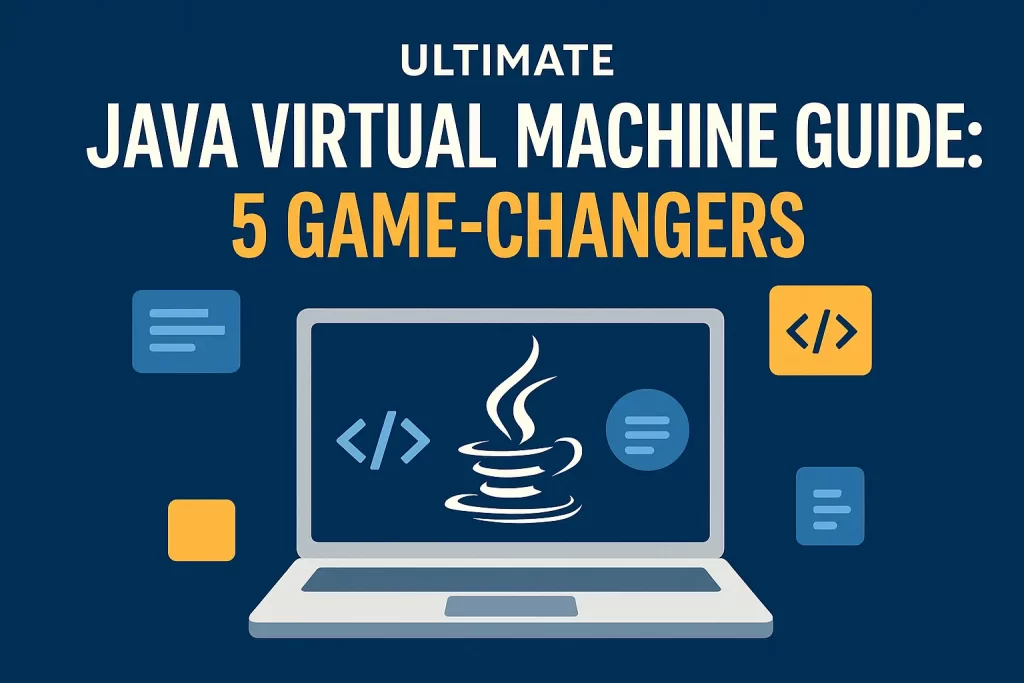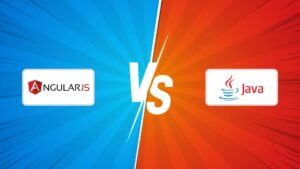
You must know how the Java Virtual Machine functions is crucial to becoming proficient in Java, regardless of experience. Java’s platform freedom and performance are largely due to the JVM. We will dissect the Interpreter, JIT Compiler, and Garbage Collector. Then there are three main parts of its execution engine. You’ll learn how the JVM manages memory and translates your code into machine-level instructions. So, it makes Java dependable and developer-friendly. Let’s get started!
Table of Contents
- What is Java Virtual Machine?
- What is the Use of Java Virtual Machine?
- What are the Different Ways of Java Virtual Machine?
- Architecture of Java Virtual Machine
- How Does Java Virtual Machine Work?
- How Does Execution Engine Manage System Resources?
- Memory and Garbage Collection
- Why JVM is Needed?
Let’s get started.
What is Java Virtual Machine?
The Java Virtual Machine (JVM) is a core part of Java technology that enables Java applications to run on any device or operating system. It reads and executes Java Bytecode, a compiled version of Java source code.
When you write Java code, it’s first compiled into Bytecode by the Java compiler. This Bytecode is not platform-specific. The JVM then interprets or compiles it further into machine code that’s specific to the host system. This “write once, run anywhere” capability is made possible by the JVM.
JVM is part of the Java Runtime Environment (JRE). It can be implemented in software or hardware, but most commonly, it’s a software-based engine. Together with Java APIs, the JVM forms the complete Java Platform.
A popular implementation of the JVM is HotSpot, which optimizes code execution through just-in-time (JIT) compilation, improving performance for frequently used code.
What is the Use of Java Virtual Machine?
The Java Virtual Machine (JVM) runs Java programs by reading and executing the compiled Java Bytecode. It acts as the core engine of the Java platform, making sure your code works on any device or operating system.
Here’s what the JVM does:
- Loads Java class files.
- Verifies the code for security and correctness.
- Executes the code line by line.
- Manages memory and system resources automatically.
In short, the JVM lets Java run anywhere, handles complex tasks behind the scenes, and keeps programs fast and safe.
What are the Different Ways of Java Virtual Machine?
Java Virtual Machine (JVM) is defined in three different ways as follows:
-
The JVM Specification
The JVM is a software specification where its working is specified. However, the execution provider is completely authorized to choose the algorithms.
-
The JVM Implementation
The right execution of the SPECIFICATIONS results in an actual software that is called JVM implementation, known as JRE (Java Runtime Environment). There are so many implementations of both open source and proprietary.
-
The JVM Instance
Once JVM Specification is implemented correctly and published as a software product, it can be downloaded and run as a program. This downloaded program is the JVM instance.
The Architecture of Java Virtual Machine
Hope the above explanation answered the question – What is Java Virtual Machine? Now, let’s understand the architecture of the Java Virtual Machine. The JVM architecture consists of a classloader, memory area, execution engine, and more.
ClassLoader
The class loader helps in loading class files. It performs three functions – Loading, Linking, and Initialization.
Method Area
Java Virtual Machine method area stores class structures such as metadata, the regular runtime pool, and the code for methods.
Heap
Heap stores all the objects, their related instance variables, and arrays. This is because memory is common and shared over multiple threads.
JVM language Stacks
JVM language stacks store local variables, and it is partial outcomes. Each thread comes with its own JVM stack, created concurrently as the thread is created. When a method is invoked, a new frame is created and deleted when the method invocation process is complete.
PC Registers
The PC register has the address of the JVM instruction which is currently executing, In Java, there is a separate PC register for each thread.
Native Method Stacks
Native method stacks store the instruction of native code that depends on the native library. It is coded in other languages instead of Java.
Execution Engine
This software is used to test hardware, software, or entire systems. The test execution engine does not store any data about the tested product.
Native Method interface
It is a programming framework that allows Java programs that are running in a Java Virtual Machine to call by libraries and native applications.
Native Method Libraries
Native Libraries is a group of Native Libraries (C, C++) that are required by the Execution Engine.
How Does Java Virtual Machine Work?
Java Virtual Machine acts as a run-time engine to run Java applications. Java calls the main method available in Java code.
JVM is a part of the Java Runtime Environment (JRE).
Java applications are based on the concept of Write Once Run Anywhere (WORA). So, you need to write the Java programs only once and can run the programs on multiple platforms without modifying the Java code.
When a .java file is compiled, the compiler creates the .class files (containing byte-code) with the same names as that of the class available in a .java file.
When a .class file is run, it undergoes various steps.
Components of the Java Execution Engine
The Java Execution Engine is the part of the Java Virtual Machine (JVM) that runs your Java programs. It takes the compiled bytecode and turns it into machine-level instructions that your system can understand. It includes three key components:
1. Interpreter
The Interpreter reads and executes bytecode one instruction at a time. This allows Java applications to start quickly, which is helpful for short-lived or small programs.
However, interpreting every instruction again and again slows things down when the same code runs repeatedly.
That’s where the JIT Compiler helps improve performance.
2. JIT Compiler (Just-In-Time Compiler)
The JIT Compiler comes into play when the JVM detects that a method is used frequently. It compiles the entire method into native machine code, allowing the JVM to skip interpretation and reuse compiled code, speeding up execution.
Key components of the JIT Compiler:
-
Intermediate Code Generator: Converts bytecode into an intermediate form.
-
Code Optimizer: Removes unnecessary instructions and improves efficiency.
-
Target Code Generator: Creates fast, optimized machine-level code.
-
Profiler: Monitors program behavior to guide smart compilation decisions.
3. Garbage Collector (GC)
In traditional languages like C or Fortran, developers must manually manage memory. If they forget to free unused objects, it leads to memory leaks.
Java automates this process with its Garbage Collector (GC). It continuously runs in the background to:
-
Identify unused objects in memory
-
Free up space by removing them
-
Prevent crashes like
OutOfMemoryError
Thanks to the GC, Java developers can focus on writing business logic, while the JVM handles memory cleanup for them.
How Does Execution Engine Manage System Resources?
The Java Virtual Machine disposes the unused memory and, this garbage collection is the mechanism, which actually does that disposal. It also allocates and maintains the referential structure that is taken for granted by the Hire Java developers. Apart from the memory, this execution engine is responsible for managing the resources for file system access and the network I/O. This machine is interoperable across operating systems. For every application’s requirement, the implementation, the engine should be responsive to every Operating system’s environment. This is how the JVM becomes capable of handling all in-the-wild demands.
Memory and Garbage Collection
One of the most common interactions with Java Virtual Machine is all about, “heap and stack”. It displays the memory usage and adjusts the JVM’s memory settings.
In JVM, the memory is managed through a garbage collection feature which is a contrasting method used in other programming languages. However, earlier program memory was a daunting task that was left only for developers to handle.
The garbage Collection feature of JVM always keeps an eye on the program to identify the empty space and remove unused memory to increase performance. The garbage collection is handled inside the JVM instead of the program. Moreover, the process uses the developer’s and operator’s specifications for individual program use.
Why JVM is Needed?
The Java Virtual Machine (JVM) is essential because it acts as the engine that runs Java applications. It ensures that Java programs run smoothly, securely, and consistently across different systems—without rewriting code for each platform.
Here’s what makes the JVM so important:
1. Loads Java Code
The JVM loads compiled bytecode from .class files into memory. This is the first step in executing any Java program.
2. Executes Code
Once loaded, the JVM executes the bytecode, translating it into native machine instructions that the host system can understand.
3. Validates Code for Safety
Before execution, the JVM verifies the bytecode to ensure it doesn’t perform unsafe operations. This helps prevent security breaches and system crashes.
4. Provides a Platform-Independent Runtime
The JVM enables write once, run anywhere by creating a consistent runtime environment across all operating systems—making Java highly portable.
5. Manages Memory Automatically
It allocates a dedicated memory area, including:
- Heap memory for object storage
- Stack memory for method execution
- Registers for internal processing
6. Runs Garbage Collection
The JVM includes an automatic garbage collector, which removes unused objects from memory, preventing memory leaks and improving performance.
7. Handles Errors Gracefully
It monitors program execution and can report critical errors, such as OutOfMemoryError or StackOverflowError, helping developers debug issues.
8. Supports a Standard Class File Format
The JVM uses a well-defined class file format, ensuring that all Java programs follow a consistent structure. This helps with code portability and reusability.
To Conclude
However, the JVM (Java Virtual Machine) was primarily developed for only JAVA but now, it allows several other scripting and programming languages including Kotlin, Groovy, and Scala. Also, other programming languages like Python with Jython, Common Lisp with Armed Bear Common Lisp, Ruby with JRuby, and JavaScript with Rhino can also run on top of it. Looking forward, it can be said that there is a bright future for JVM, and we can see it as a prominent part of the java development company landscape for sure.
FAQs
Q What is a Java virtual machine?
Java programs can run on a variety of platforms and operating systems for Java Virtual Machine (JVM). By converting Java bytecode into machine-elective code, which can understand special hardware, it acts as an interpreter. Because JVM is platform-independent, Java developers can make their code once and run it anywhere.
Q What is the role of Java virtual machine in program execution?
Java Bytecode can be thanked for a virtual machine called JVM. Between Java programming language and real hardware, JVM serves as an interpreter. It provides a runtime environment that enables Java apps to run on various operating systems and platforms.
Q What do you understand by java virtual machine?
Programming languages that work on JVM and compile the Java Bitecode are known as JVM languages (eg, Kotlin, Skala). Although it can have its own syntax and characteristics, it uses JVM’s runtime environment. The actual software that decodes and drives the Java Bitecode is called JVM implementation (such as Oracle Hotspot or OpenJDK).
Q What is a Java Virtual Machine launcher?
The purpose of slightly executable software known as the native Java launcher is to load and launch your Java application. In addition to adding capacity and changing Java.exe successfully, it also provides better operating systems integration and a more user friendly interface.
Q Which JVM version is the most recent?
The most recent edition of the Java SE platform is JDK 24. The most recent Java SE platform is the Long-Term Support (LTS) release JDK 21.






